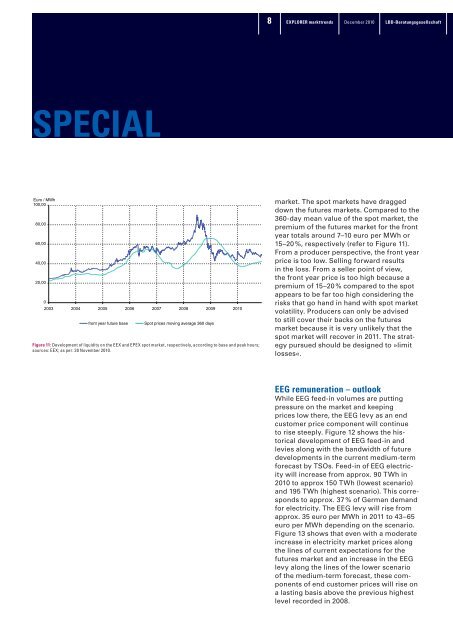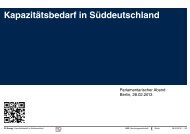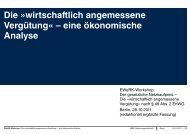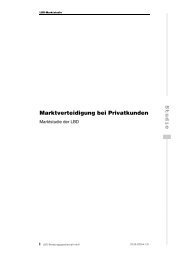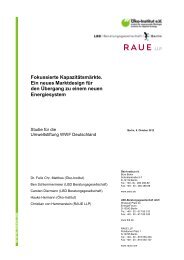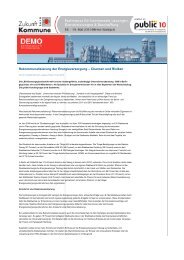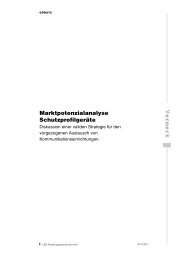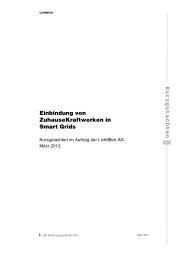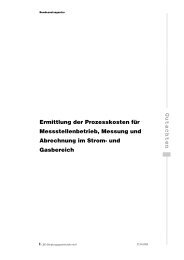EXPLORER special on generation - LBD-Beratungsgesellschaft mbH
EXPLORER special on generation - LBD-Beratungsgesellschaft mbH
EXPLORER special on generation - LBD-Beratungsgesellschaft mbH
Create successful ePaper yourself
Turn your PDF publications into a flip-book with our unique Google optimized e-Paper software.
SPECIAL<br />
Euro / MWh<br />
100,00<br />
80,00<br />
60,00<br />
40,00<br />
20,00<br />
0<br />
2003 2004 2005 2006 2007 2008 2009 2010<br />
fr<strong>on</strong>t year future base Spot prices moving average 360 days<br />
figure 11: Development of liquidity <strong>on</strong> the EEX and EPEX spot market, respectively, according to base and peak hours;<br />
sources: EEX; as per: 30 November 2010.<br />
8<br />
<str<strong>on</strong>g>EXPLORER</str<strong>on</strong>g> markttrends<br />
December 2010<br />
Lbd-beratungsgesellschaft<br />
market. The spot markets have dragged<br />
down the futures markets. Compared to the<br />
360-day mean value of the spot market, the<br />
premium of the futures market for the fr<strong>on</strong>t<br />
year totals around 7–10 euro per MWh or<br />
15–20 %, respectively (refer to Figure 11).<br />
From a producer perspective, the fr<strong>on</strong>t year<br />
price is too low. Selling forward results<br />
in the loss. From a seller point of view,<br />
the fr<strong>on</strong>t year price is too high because a<br />
premium of 15–20 % compared to the spot<br />
appears to be far too high c<strong>on</strong>sidering the<br />
risks that go hand in hand with spot market<br />
volatility. Producers can <strong>on</strong>ly be advised<br />
to still cover their backs <strong>on</strong> the futures<br />
market because it is very unlikely that the<br />
spot market will recover in 2011. The strategy<br />
pursued should be designed to »limit<br />
losses«.<br />
EEg remunerati<strong>on</strong> – outlook<br />
While EEG feed-in volumes are putting<br />
pressure <strong>on</strong> the market and keeping<br />
prices low there, the EEG levy as an end<br />
customer price comp<strong>on</strong>ent will c<strong>on</strong>tinue<br />
to rise steeply. Figure 12 shows the historical<br />
development of EEG feed-in and<br />
levies al<strong>on</strong>g with the bandwidth of future<br />
developments in the current medium-term<br />
forecast by TSOs. Feed-in of EEG electricity<br />
will increase from approx. 90 TWh in<br />
2010 to approx 150 TWh (lowest scenario)<br />
and 195 TWh (highest scenario). This corresp<strong>on</strong>ds<br />
to approx. 37 % of German demand<br />
for electricity. The EEG levy will rise from<br />
approx. 35 euro per MWh in 2011 to 43–65<br />
euro per MWh depending <strong>on</strong> the scenario.<br />
Figure 13 shows that even with a moderate<br />
increase in electricity market prices al<strong>on</strong>g<br />
the lines of current expectati<strong>on</strong>s for the<br />
futures market and an increase in the EEG<br />
levy al<strong>on</strong>g the lines of the lower scenario<br />
of the medium-term forecast, these comp<strong>on</strong>ents<br />
of end customer prices will rise <strong>on</strong><br />
a lasting basis above the previous highest<br />
level recorded in 2008.


